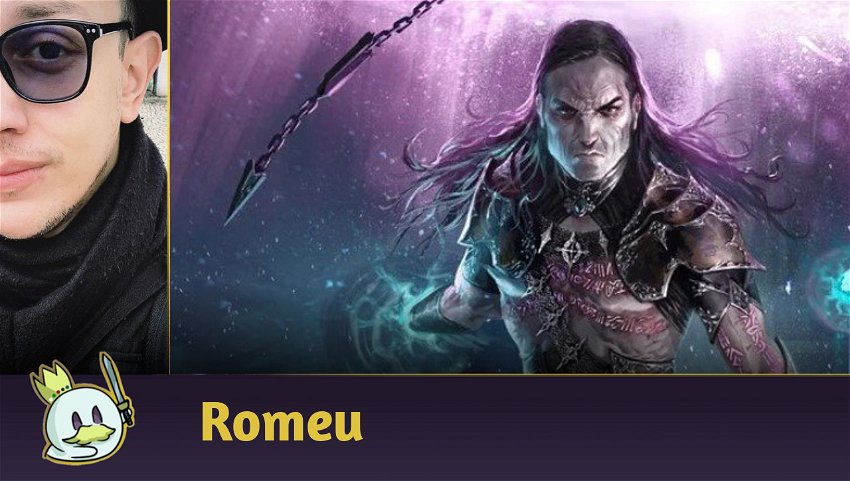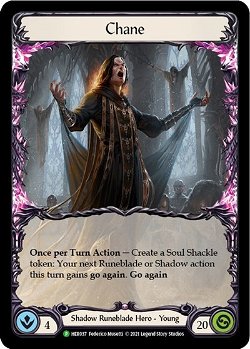Flesh and Blood came out in Brazil just over a month ago, and since then, Armory events have been taking place in various stores in the Blitz format. In case you haven't opted for a deck yet, at the beginning of December we will bring a guide to the classes and heroes of the format so that players can find the strategy that best fits their taste.
During this period, the hero I've been dedicated to is Chane, especially because his play style reminds me of one of my favorite Magic: The Gathering archetypes, Death's Shadow, where its plays are always high-risk and high reward, and you can't afford to make too many mistakes. Today, I'll be covering one of the deck's versions that I've been piloting, as well as bringing a budget alternative.
About Chane in Blitz

Chane is a Shadow Runeblade deck, in the world of RPGs, its equivalent would be something like the Dark Knight job from the Final Fantasy series. Like every Runeblade, the hero resorts to attack damage and arcane damage, but is not entirely focused on either, although leaning more towards attacks.

Rosetta Thorn is the perfect example of how this damage is divided and/or shared: its attack deals an extra amount of arcane damage if you play an Attack Action and an Action on the same turn. Being the best weapon for the class today, and making Runeblade deckbuilding in both Blitz and Classic Constructed involves a good mix of Attacks and Non-Attacks.
Equipment

In a non-budget version, your equipment setup will be as exemplified above, with a possible change in the helmet slot, as some lists opt for Arcanite Skullcap and, for me, this varies greatly on card availability and /or the Metagame you expect.
Crown of Providence grants a 2 block without any drawbacks, and we can always remove a useless card from our hand or arsenal to draw a card in times of need.
Carrion Husk is the only piece of equipment that, if you intend to play Chane, you should consider investing in it ASAP: its sole function is to block six damage. However, its use needs to be well calculated, as it will be banished if you have 13 or less life, so you can't wait too long to use it, but in a fast format like Blitz, this block means an extra turn, and it's common to use it for so you don't need to spend cards from your hand to defend yourself and then hit back aggressively. Flesh and Blood is a game of constantly switching resources between attackers and defenders, and Carrion Husk guarantees you don't need to deplete your resources the next turn for at least one attack.
Grasp of the Arknight, in addition to blocking for 2, is also a great resource sink. The ability to create Runechant tokens with what's left over at the end of a turn, or granting extra arcane damage before an attack, makes a difference in the long run.
Finally, Spellbound Creepers is a complex piece of equipment to use because it allows for a severe amount of small tricks during the match by allowing you to use, upon activation, a Non-Attack Action as if it were an Instant. That means securing an unexpected go again with Captain's Call, or an ill-timed +3 with Minnowism (1), among others.

Other important equipment are the one that guarantees Arcane Barrier for matchups against Wizards, and fortunately, Runeblades have good pieces that protect against arcane damage, except in the boots and chest slots, where we are forced to play with a Nullrune set.
The Decklist
This list is mostly inspired by the version ran by Rob Catton at the World Championship, with a few slight modifications that better suit my taste, in particular the inclusion of two copies of Captain's Call (2).
Chane as a hero focuses on his ability to create Soul Shackle tokens, which allow gives go again to the next Shadow or Runeblade action on the turn.

The consequence, however, is that Soul Shackles stack up, and for each one of them, you must, at the start of your turn, banish the top card of your deck. That is, gradually, you will "mill" your deck and important resources, except that Shadow archetypes were made to take advantage of this theme.

A large portion of Shadow-type cards have one ability in common: Blood Debt, where you lose 1 life at the end of your turn for each card with that ability in your banished zone.
However, Shadow Runeblade's actions allow you, under some condition, to play them from the banished zone. That is, while you are banishing cards from your deck with Soul Shackles, you are also accumulating more resources for your next turns, making Chane's "drawback" work virtually like a second hand, but under the consequence that if you abuse its ability and the game drags on, Blood Debt damage can build up quickly.
So, Chane's goals are:
1) Make sure you have a good mix of Attack Actions and Actions.
2) Have enough Blood Debt cards to take advantage of the hero's ability.
3) Aim to perform three or more attacks in a turn to mitigate the odds of taking too much collateral damage from cards in the banished zone.

Sounds like a lot, but the list is built to make everything work as expected: cards like Mauvrion Skies (3), Shadow Puppetry, and Captain's Call (2) guarantee go again for your attacks, and the fact that the hero himself already guarantees this effect at least once in the turn with the Soul Shackles greatly facilitates the ability to attack three or more times in the same turn.

The extra power not only counts with Howl from Beyond as a pump that can be played from the banished zone and Plunder Run (1), a card so efficient that it was banned from Classic Constructed, but also from the interaction between Belittle (1), Minnowism (1) and a large portion of Attack Actions, which have 3 or less power.

This interaction is also essential to guarantee tons of decisions during a game because while Minnowism (1) increases the power of the next Attack Action by three, Minnowism (3) gives you three resources to pitch, and often guarantees the necessary cost to play heavier cards, like Howl from Beyond (1), or on turns where you want to perform a long chain, preferably with Art of War.

Art of War, one of Flesh and Blood's generic staples, is especially brutal with Chane, as in addition to its flexibility in granting stronger attacks or blocks on the turn, the possibility of banishing a card with Blood Debt from your hand to draw two is pure card advantage, and it is common for Art of War turns to be those where the opponent is forced to deplete their own resources to survive.

Soul Reaping is virtually a 6 damage for free if you have another card in your hand, and creates resources if the cards you banish with it have Blood Debt, granting you enough to play them if needed.
As for the pieces that don't interact directly with the deck's engine, they are powerful in their own right: Vexing Malice deals two arcane damage in addition to its normal attack damage. The blue version looks unimpressive, and it's common to use it for pitching, but that extra damage can decide games in later stages, where the opponent may be forced to choose to protect themselves from another of your attacks and run out of resources to activate their gear's Arcane Barrier.
Shrill of Skullform (3), in addition to granting three resources, interacts with Belittle and Minnowism, while naturally hitting for five with a Soul Shackles activation.
The final numbers on the list are 13 blue cards to grant resources and play around Frostbite from heroes like Oldhim, Lexi, and Iyslander, 14 cards with Blood Debt, 18 cards that interact with Belittle (1) and Minnowism (1), plus 15 Actions and 23 Attack Actions, round enough to guarantee Rosetta Thorn's arcane damage.
Budget Version

In the budget version, since we give up on Carrion Husk (and again, it's the best investment you can make for Chane), we put Ironhide's full set to block 6 damage on an opportune turn, with the pitch of a blue card from your hand.
However, the ideal setup in the budget version would be this:

You can opt for Crown of Dichotomy or Ebon Fold, but I think that most games will have physical damage involved, and it is necessary to measure how much damage you are willing to take/block with your equipment, and without Carrion Husk, this account is way harder for Chane.
Aether Ironweave grants more resources on explosive turns, while Vexing Quillhand grants additional arcane damage, and Snapdragon Scalers provides go again as an Attack Reaction to most attacks on the list.

The only replacement on the list is Mauvrion Skies (1) instead of Art of War since, despite not granting the same flexibility and benefits, the red Action, in addition to giving go again, can create three Runechant tokens if the attack deals damage to the opponent, and works great to force block with cards in hand at an inopportune moment, or to pull three extra points of damage on your next attack.
Advantages and Disadvantages
Chane is an aggressive archetype that seeks to sustain a lot of damage with a sequence of attacks in the same turn. However, it doesn't run out of steam as quickly as other Aggro due to the interactions of the Blood Debt cards, making it a solid option for securing one or two attacks from the banished zone with just a blue pitch from your hand.
In addition, he is very adaptable to what you expect to face, and the fact that he attacks with different sources makes it difficult for the opponent to decide which is the ideal setup to deal with him, as despite the well-established core, the flexible slots can greatly vary in the deck's proposal, not counting the possibility of versions with Swarming Gloomveil and Revel in Runeblood, as well as "go tall" attacks, such as Enlightened Strike and Shrill of Skullform (1).
His inherent weakness, however, is that he doesn't attack as often as a Ninja, nor does it damage as high as a Brute, and it doesn't have as much arcane source as a Wizard - it's somewhere in between, and any archetype that specializes in dealing with excellence against these situations might manage to have an edge against him.
Additionally, Chane requires performing more than one action per turn, making it vulnerable against taxing effects such as Frostbite or Channel Lake Frigid, or effects that make attacks lose go again, and these heroes can easily punish you if your hand doesn't have enough blue resources, but I wouldn't go so far as to say that heroes like Iyslander and Oldhim are bad matchups since, again, Chane is very flexible.
On the other hand, due to the low defense of the Actions on the list, the hero has difficulties against "go tall" strategies that accumulate an absurd amount of damage in a single turn, such as against Glass Cannon Lexi, or Rhinar's most explosive turns, which force you to spend many resources to survive for a turn, as Chane is not usually fast and aggressive enough to take such a high amount of damage and win on the next turn on early game.
Conclusion
Chane is one of the most famous heroes in Blitz today, and one of the most fun decks with the greatest learning path I've piloted since I started in the game. He has the potential to perform absurd sequences, but also manages to behave well outside an "All-In" proposal, which makes him a solid option for events.
Thanks for reading!














— Comentarios 0
, Reacciones 1
Se el primero en comentar